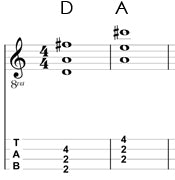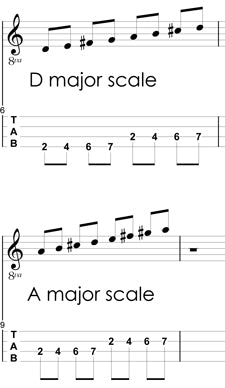The Symmetrical Tuning of the Tenor Banjo
The tenor banjo is tuned using a symmetrical tuning. A symmetrical tuning is a tuning that has the same musical interval between each string. In western music, the four main instruments in the string family all have a symmetrical tuning.
These are violin, viola, cello, bass.
All except the bass are tuned in fifths. A bass is tuned in fourths. The mandolin family copies these tunings in fifths:
mandolin = violin
mandola = viola
mandocello = cello
Click here to learn what a fifth is.
Their tunings from the lowest note to the highest is:
Violin/Mandolin = G, D, A, E
Viola/Mandola = C, G, D, A
Cello/Mandocello = C, G, D, A (an octave below the viola)
Bass = E, A, D, G
This relates to the tenor banjo because standard tuning for a tenor banjo is tuned the same as a viola/mandola (C, G, D, A). Irish players often tune their tenor banjos also in fifths, but one octave below a violin/mandolin (G, D, A, E).
A tenor banjo is a short necked banjo that has 4-strings.
Nobody really knows where the name "tenor" banjo came from. By calling it a "tenor" it gives the impression that it would be a lower pitched instrument because in classical four part harmony, the parts go from high to low, soprano, alto, tenor, bass.
This is not the case. When compared to other banjos, it is the highest pitched.
There are two variations of this instrument, a 17-fret and a 19-fret type. The more standard type is the 19-fret, though the 17-fret is very common amongst Irish players because the smaller scale length makes it a bit easier to play the quick reels and triplet passages in that style of music.
The tenor banjo was originally made for viola players to double on, that is why it is tuned the same as a viola. The “Irish” tuning makes it easy to play the fiddle melodies in Irish music because of it being the same as violin, only an octave lower.
 By nature, the tuning of the tenor banjo in fifths inherently has a major advantage in that chord voicings and scale patterns are symmetrical. The intervallic relationship between an adjacent string is the same. This means that if you make a triad on the fourth, third, and second strings with the root in the bass, a triad shape would be the same if you moved it up one set of strings to the third, second, and first strings.
By nature, the tuning of the tenor banjo in fifths inherently has a major advantage in that chord voicings and scale patterns are symmetrical. The intervallic relationship between an adjacent string is the same. This means that if you make a triad on the fourth, third, and second strings with the root in the bass, a triad shape would be the same if you moved it up one set of strings to the third, second, and first strings.
 The same type of thing works with scalar patterns. The shape of a major scale on the fourth and third strings would be the same as if you moved it to another set of strings, let's say the third and second.
The same type of thing works with scalar patterns. The shape of a major scale on the fourth and third strings would be the same as if you moved it to another set of strings, let's say the third and second.
This allows you to transpose any lick anywhere on the neck without changing your fingerings. For instance, if you had a D chord lick, you could easily transpose that to an A chord lick by just moving it up one set of strings. This all greatly reduces the number of different fingerings you need to learn for different licks, scales, and chord shapes. The only downsides are that some classic guitar style blues licks are harder to reach, as well as the need to stretch a bit more to play a scale.
Check out a tenor banjo and its symmetrical tuning and see how much fun it can be.


















I have a 19 fret tenor. It is tuned cgda. My question is whether it can be tuned gdae? I assume different strings would be necessary. Thanks
The tenor banjo is tuned lower than the popular Banjolin Banjo/mandolin which has eight strings the courses tuned in pairs like a mandolin G D A E low to high. This may explain why the Tenor is so named. Cheers Percy
Many years ago, before light gauge stings were available for guitar, I used to string my guitar down, using a ball end tenor A banjo string, in place of the E first guitar string. Do you have any idea what the gauge of that string was?
Leave a comment